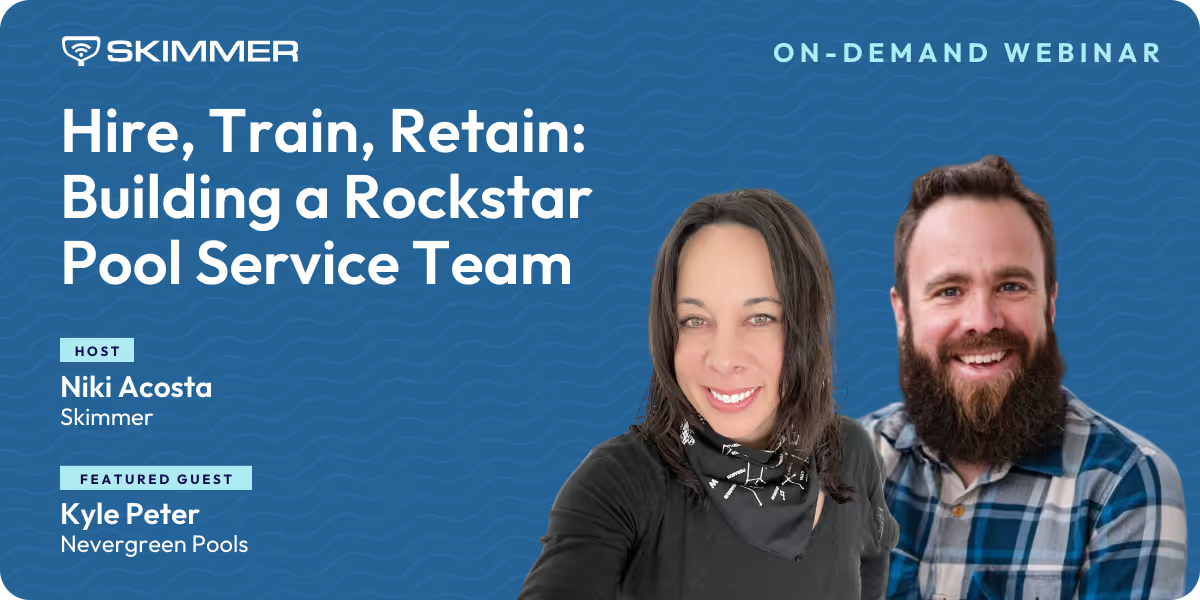
This blog post is a summary of a Webinar co-hosted by Niki Acosta and Kyle Peter. Watch the full webinar on demand here.
Finding—and keeping—the right employees is a challenge in any industry. For pool pros, it can be especially difficult. In our 2025 State of Pool Service report, survey respondents listed hiring, training, and retaining top talent as one of the top three challenges of running their pool service business.
It’s also an expensive challenge to face. 35% of pool service company budgets are allocated to people-related expenses, and for most pool business owners, the cost of bringing on a new employee is between $2,500 and $10,000 (but can be as high as $20,000).
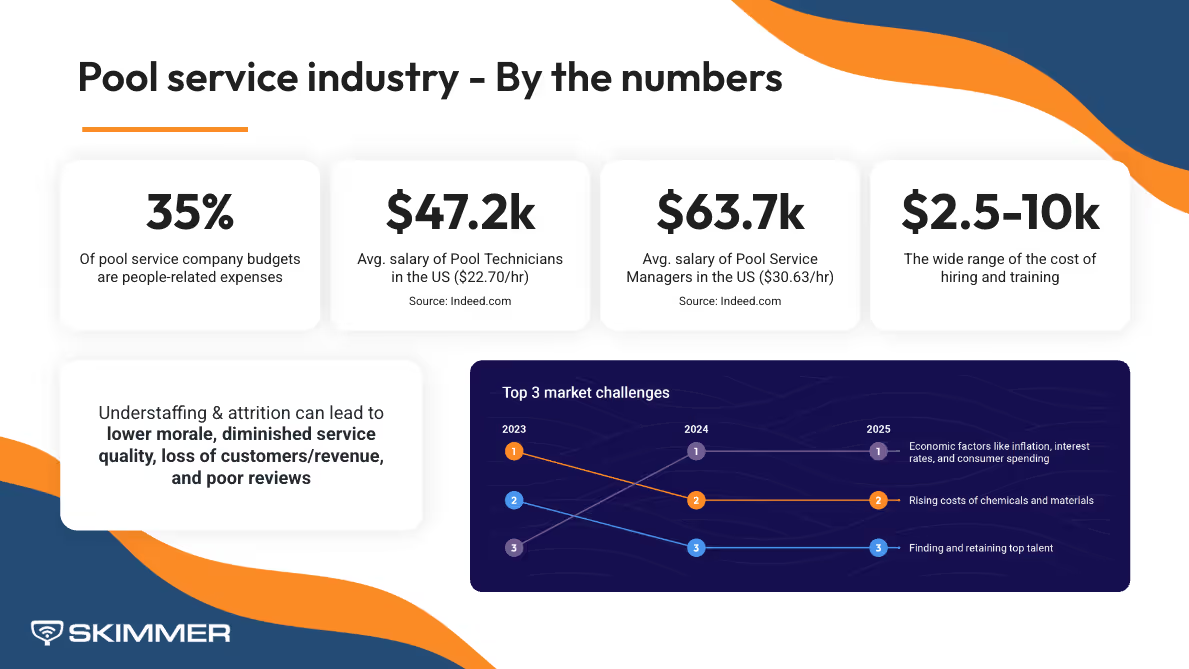
The key to reducing employment challenges and expenses is twofold: You have to hire great people and then keep them.
If anyone knows how to do that, it’s Kyle Peter. In just seven years, he’s grown Nevergreen Pool Service from a solo operation with one pickup truck to a team of 20 that serves over 1,000 residential pools weekly and prides itself on excellent customer service. Clearly, he’s done more than a few things right.
He recently sat down with Skimmer’s Niki Acosta, to give his top tips for hiring, training, and retaining great people in the pool service industry.
Attracting and hiring great candidates
There are a number of avenues you can explore to find a new technician, and Kyle has tried them all. In his experience, any of the following are viable ways to find a great candidate:

- Online hiring sites like Indeed or Craigslist.
- Trade associations like UPA or IPSSA.
- Facebook pages and regional Facebook groups.
- Referrals from current employees.
- Distributors, who, as Kyle says, “Have a wealth of knowledge in all aspects of your business.”
- Your personal network of family, friends, and colleagues.
- People you meet out in the real world, like a store clerk with great customer service skills who you can offer a little more money to.
No matter how you’re finding candidates, look for signs that they align with the type of service you already offer. Because one of Nevergreen’s top company priorities is providing great customer service, Kyle has been known to hire people he sees doing a great job at the local hardware store or car wash. “If you’re talking to a really engaging person who’s friendly and has great customer service skills, you can teach them to be a pool tech, but those skills are hard to find,” he says.
Tip: Keep a database of potential candidates. If you cast a wide net during your search, you might meet more great people than you can hire. Kyle recommends keeping a database of people you’ve met to make your next candidate search an easier one.
Interviewing candidates
The interview is an important step in the hiring process, if only because it gives you a chance to see what a potential candidate is like in person. As Kyle says, “We can usually tell within three to five minutes whether we’re going to hire a person or not. Do they smile? Are they friendly? Are they charismatic? Do they have the soft skills that are absolutely necessary for this work?” If not, they’re not the right fit for Nevergreen.
No matter where you’re at in your business’s growth journey, it’s helpful to have a bank of questions ready for interviews. Using a blended approach of behavioral questions (“Tell me about a time when you…”), situational questions (“What would you do if…”), and technical questions (“Tell me how you would run a chemistry test”) can level the playing field and help you quickly see how a person is thinking about the job opportunity.
If the initial interview goes well, you also have the option to take a candidate on a ride-along or working interview to observe their real-world performance.

Creating a job description and offer letter
Once you’re ready to make an offer, provide the candidate with a written job description and offer letter. These documents are necessary to provide and get your new employee to sign from a legal standpoint, but they’re also a great way to set expectations up front and give employees the high-level, important information they need to know to thrive in their role.
The offer letter itself should include details like:
- The employee’s start date
- Employment type (for what it’s worth, Kyle only ever hires employees, not contractors. As he puts it, “If you’re a company that offers pool service, you can’t subcontract that out.”
- Probation period (All Nevergreen employees go through a 90-day trial period)
- Pay rate (Kyle pays his technicians by the hour)
- Paid time off (PTO) details
- Company holidays
- Technology the technician will be expected to use
- Company vehicle policy
- Equipment and chemicals the employee will be using
- Policies around major equipment use
Think of these documents as your new employee’s first glimpse into the culture they’ll be a part of. When you’re clear about expectations and what’s important to your company, you’re giving new hires the best possible chance of succeeding in their new role. And by getting a signature, you’re also getting them to agree to those terms.
Onboarding and training
As Nevegreen has grown as a company, so has its onboarding process. “We used to hire techs and throw them on ride-alongs right away, but they missed being adopted into our company culture and understanding our processes,” says Kyle.
Today, the process is much more formalized. Kyle welcomes each new hire to the company with a two-hour orientation session, during which he walks them through Nevergreen’s company values, goals, mission statement, PTO, and sick day policies, and more.
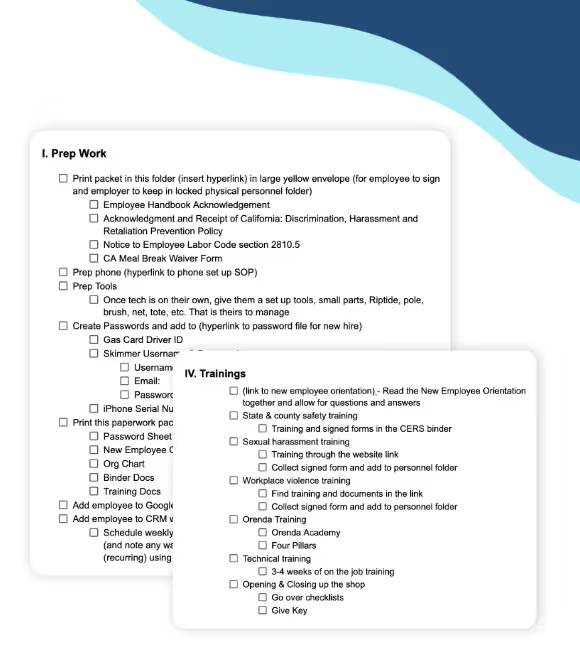
This orientation is part of a greater set of onboarding and training standard operating procedures (SOPs) that Kyle and his team have developed over time. “There’s a lot of work and paperwork to complete, both before, on, and after the [employee’s] first day,” says Kyle. Having SOPs ensures that the process is repeatable and valuable for both Nevergeen and each new hire.
Training and the first 90 days
After onboarding comes a three-week training period that Kyle considers an extended part of the consideration process. “We hire quick and fire quick,” he says, so training is, “Essentially a three-week ride-along where we’re still in the interview process.”
Nevergreen also makes it very clear to new employees that their employment is subject to a 90-day trial period. “Within that 90 days,” says Kyle, “Employees need to be able to test water, run the Orenda calculator and balance the pool to LSI, know how to use the sanitizer and Skimmer, and handle work orders.” During this time, Kyle and the team also give new hires a lot of feedback so that new hires know where they’re excelling and how they can improve.
Much like with onboarding, Kyle and his team are always tweaking the training process. “We’re constantly reworking our internal training manual,” he says. Currently, new hires are expected to complete a checklist of training modules, from sexual harassment to safety training.
Tip: Make your onboarding and training SOPs a winter project. You’ll have more time to write them when the season slows down. At Nevergreen, “We just throw things on a whiteboard and organize from there.”
Retention and productivity
Hiring employees is one thing. Keeping them—and making sure they stay engaged—is entirely another.
There are many different reasons why an employee might leave the company:
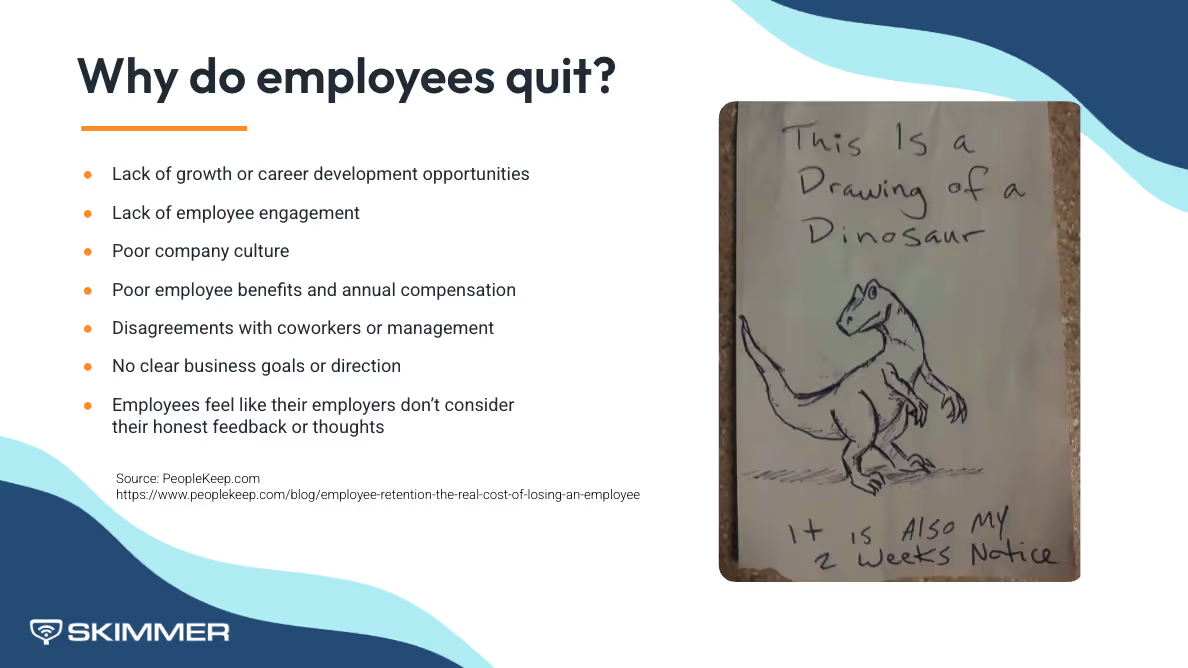
Some are within the manager’s control, and of course, others aren’t. To Kyle, the best way to keep an employee from leaving is to give them an experience that makes them want to stay. This is different for everyone. For some people, it’s money. For others, it’s the freedom to shape their own schedule day-to-day. For others still, it’s the opportunity for advancement. Kyle encourages his managers to find what that motivator is for each employee and try to shape their experience around that.
Ultimately, says Kyle, “Your job as a leader is to serve your team members. Make the time to be a leader.” He encourages his services manager to make their techs “feel like the stars of the show” every day by really listening to what they need and trying to provide it.
This might seem like a lot of work, but at Nevergreen, it’s been a worthwhile investment. “Every single person who’s worked for me started as a service technician,” says Kyle. “They all showed some type of aptitude to problem solve, show up, and be efficient. We earmark those techs and ask them, ‘What do you want to do?’” Obviously, this strategy has worked well.
Tip: Avoid the “hologram carrot”, also known as the promise of advancement, a raise, or a better life that is dangled but never arrives. Set expectations and create a clear pathway to growth that comes along with a checklist of skills for level 1, 2, and beyond.
Use KPIs to manage your team
Using key performance indicators (KPIs) is a great way to assess the health of your business and meet your goals. Nevergeen also uses hundreds of lines of data to help make decisions about their employees.
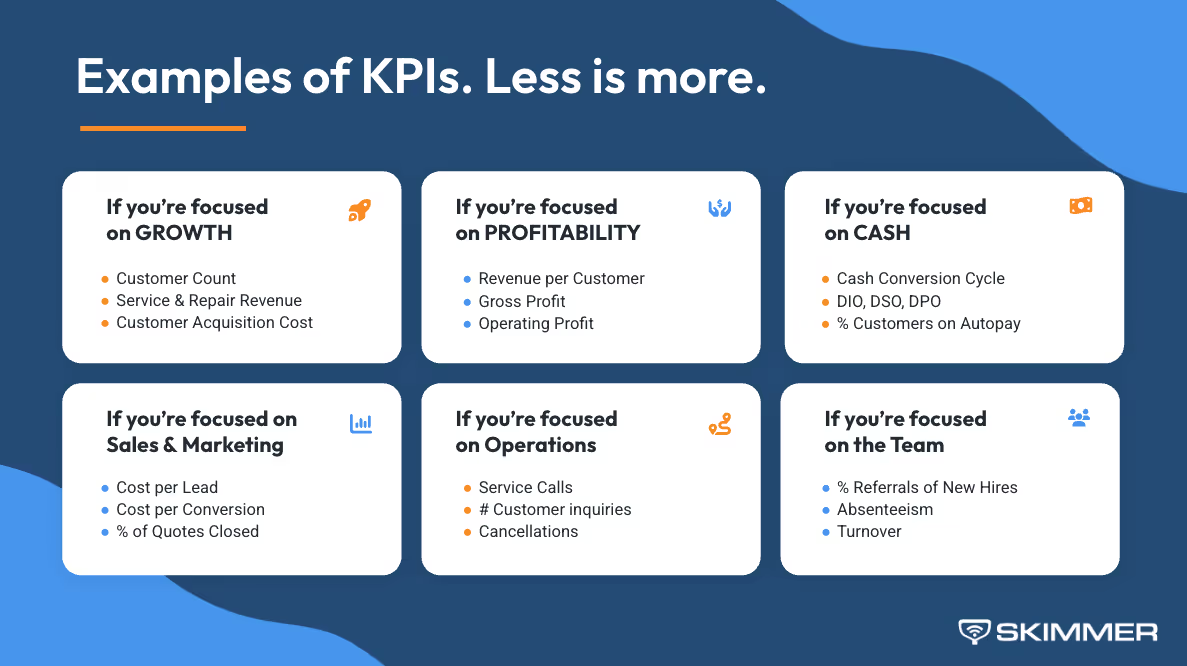
“KPIs show us how our service team is performing,” says Kyle. “We reward our service techs who help retain customers and show up to work.” KPIs are woven into weekly, quarterly, and annual meetings as well, so that every employee is aware of the overall goals and how they’re contributing to them.
Weekly meetings: Informal 1:1s between techs and their managers are a great time for managers to touch base and ask questions to figure out what motivates their employees. These are meant to be informal and can be 1-2 minutes long.
Quarterly meetings: At Nevergreen, these meetings are positive, pep-rally like meetings that are meant to celebrate wins and motivate the team. During these meetings, Kyle and the team:
- Welcome new hires and celebrate birthdays, anniversaries, and promotions
- Highlight and celebrate company wins
- Outline any new systems/processes and training plans
- Hand out awards for things like perfect attendance, small parts work orders, most efficient tech, most Google reviews generated, customer retention, and the Golden Broken Skimmer Lid award (awarded to someone who did something stupid on the job like stepped on a skimmer lid, but then fixed it).
Annual meetings: Annually, Nevergreen has a big company-wide celebration to celebrate the year’s big wins.
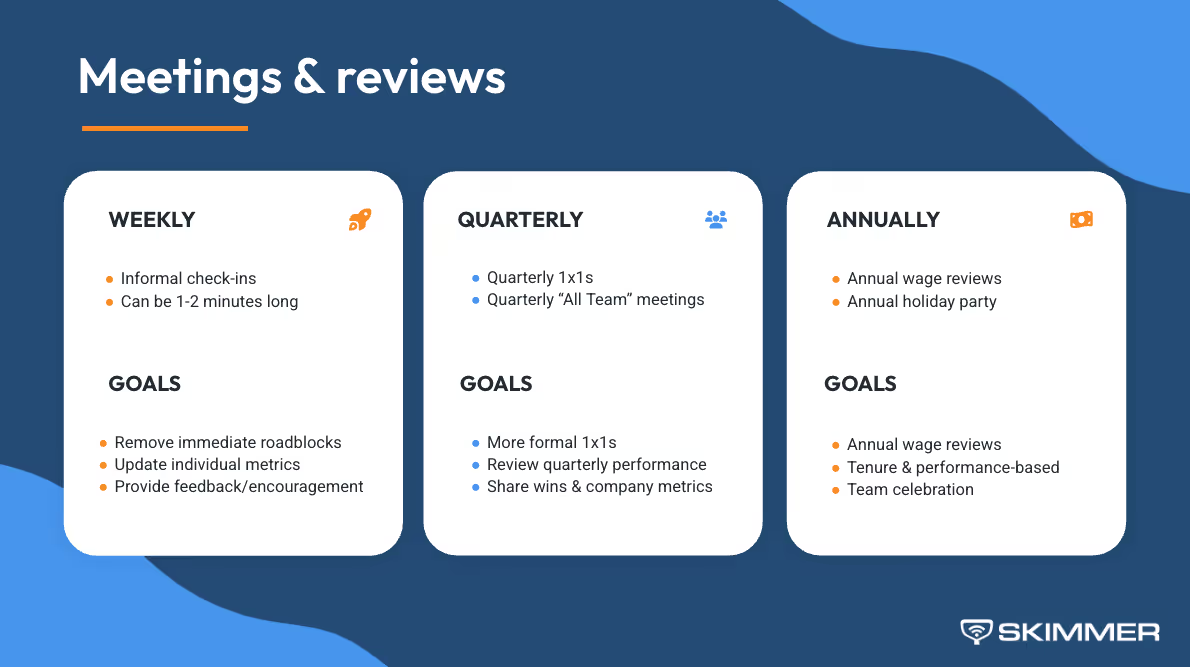
The purpose of all of these meetings is to make KPIs a part of the company culture. “The support and level of quality should be offered by the company as a whole, not by one person,” says Kyle.
Scaling your team over time
One of the biggest challenges any pool pro will face is knowing when and how to grow their team. Kyle has experienced many of these challenges over Nevergeen’s seven years. “Even scaling from one to four employees is very difficult,” he says.
To grow Nevergeen in the early days, Kyle used a leapfrog technique to hire, which basically meant only bringing on a new employee whenever the current set of employees was at max capacity. “We originally had one manager who did everything,” he says. “As you grow and scale, that person is ready to pull their hair out, so you hire someone else and create a new job description that takes some of that stuff off their plate.”
In Kyle’s experience, the most challenging period in any pool service company’s scaling journey is when they have 300-500 pools. At this stage, he says, it can be easy to forget that you need to serve your technicians and give them support, especially if you’re in the repair van with a full day of your own tasks to complete. After this stage, however, you can hire some help to focus on administrative tasks.
No matter where your company is in its growth journey, you should factor in how your labor cost and profit will change any time you hire someone new. This will allow you to avoid any surprises.
Tip: Follow the N+1 scaling formula. The correct number of technicians you need is N+1, or one more technician than what you actually need. This allows for growth, extra job coverage, sick route coverage, and unexpected quitting without notice. As Kyle says, “Your +1 tech can sweep the shop, continue training, do filter cleanings, or do quality control.”
Lessons learned
Kyle has learned a ton about what works well for Nevergreen when it comes to hiring and retaining great employees. He’s also learned just as much about what not to do. Making mistakes is inevitable, and, viewed the right way, can always be reframed as a valuable lesson.
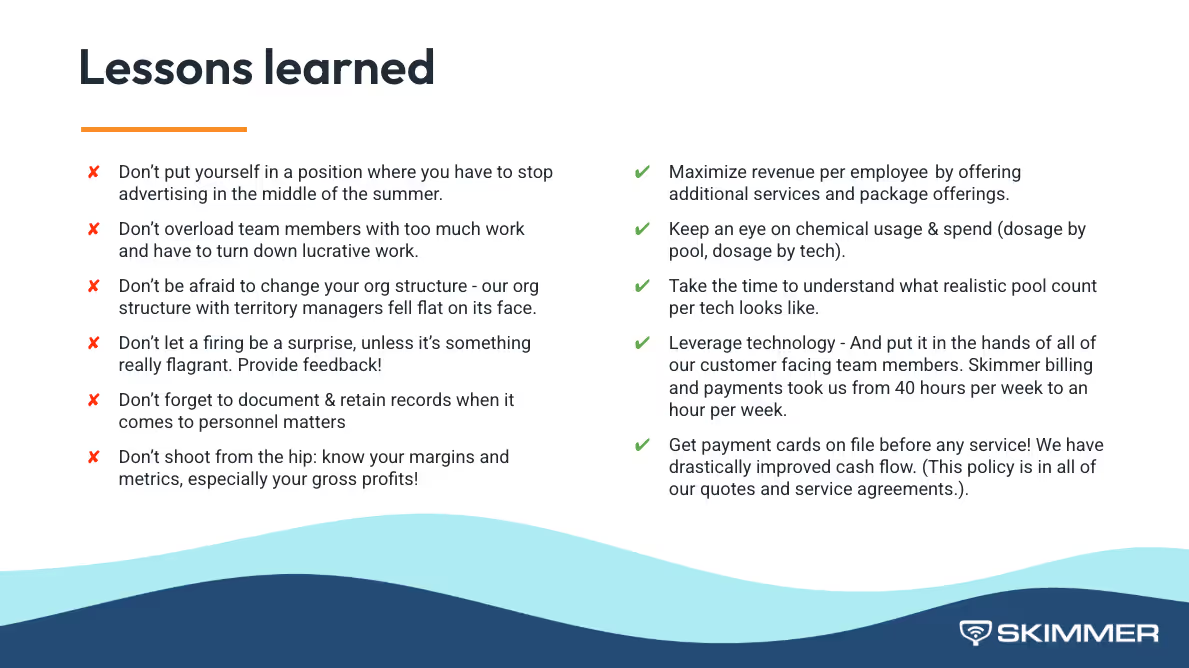
No pool company will ever grow without mistakes. But if you pay attention to what’s working, what’s repeatable, and what your employees respond to, you’ll have a much easier time finding the rockstars your company deserves and keeping them for a long time.
Hiring and retention resources from Nevergreen Pools
- Sample Employee Agreement
- Sample Onboarding Checklist
- Sample Employee Handbook
- Sample Pool Technician Interviewing Guide
- Sample Technician Levels & Advancement Path
- Sample Quarterly Meeting Template
TL;DR
Hiring, training, and retaining top talent is one of the biggest challenges pool service companies face—and one of the costliest. In this recap of a Skimmer webinar, Kyle Peter, founder of Nevergreen Pool Service, shares hard-earned insights on how to build a reliable, motivated, and long-lasting team. From scouting great talent in everyday places to crafting clear onboarding SOPs and using KPIs to fuel performance, Kyle breaks down the people-first strategies that helped him scale from a solo operation to a 20-person team serving over 1,000 pools weekly. Key takeaways include: hire for attitude and train for skill, create structured onboarding processes, track employee performance with KPIs, and always lead with service, especially to your own team.


















